26 July 2014
Running the guns — Howth,1914
From 'War by the Irish', by John McCann
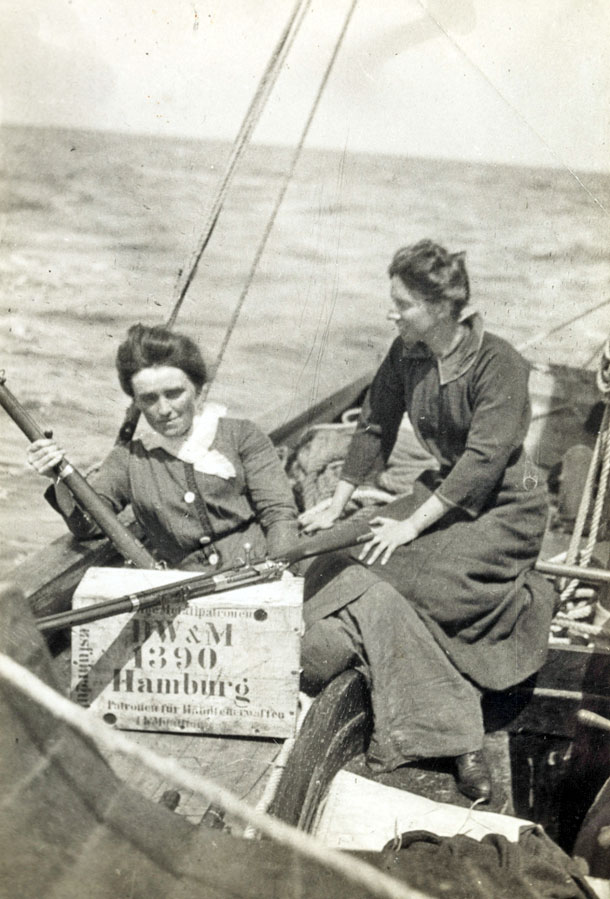
• Molly Childers and Mary Spring Rice aboard the Asgard
BARELY A WEEK after the formation of the Irish Volunteers at the Rotunda Rink in Dublin, on 25 November 1913, the British Government issued a Proclamation prohibiting the importation of arms into Ireland.
For a year previously, the Ulster Volunteers, under Edward Carson, had been receiving large supplies of arms and ammunition, paid for by English Tories, with the openly-defined purpose of opposing the application of the Home Rule measure to Ulster.
"Ulster Unionists," said The Irish Times in its issue of 6 December 1913, "are convinced that the action of the Government has come too late, and that there are now sufficient arms in Ulster to enable effective resistance to be made to any attempt to force Home Rule on Ulster."
The same newspaper, referring two days later to the Proclamation, added: "It, of course, puts an end to the arming of the Irish Volunteers."
This unionist journal, despite its first feint, summed up accurately the real intent of the Government's prohibition.
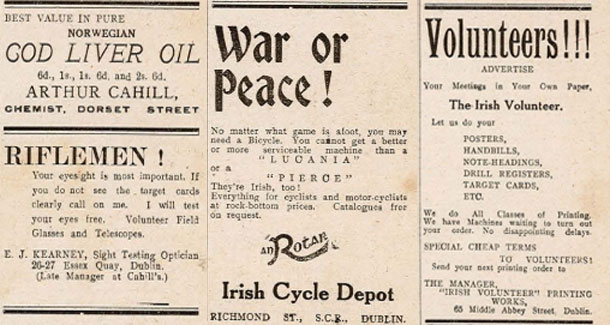
In January of 1914, the estimated strength of the Irish Volunteers was in the neighbourhood of 10,000. By June of that year, more than 100,000 men had attested. In the meantime, the Defence of Ireland Fund had been launched with the express purpose of arming Ireland's manhood. The fund was intended only to facilitate the purchase of fighting material in quantity as each volunteer paid for equipment supplied.
In London, Roger Casement had gathered around him a small committee of Irish people and by their own subscriptions and influence a considerable sum of money was available to supplement the collection in Ireland. Casement communicated with the Volunteers through Bulmer Hobson indicating plans for the purchase of arms on the Continent and asking Hobson to undertake their subsequent landing in Ireland.
Fifteen hundred Mauser rifles and 49,000 rounds of ammunition were purchased by Erskine Childers and Darrell Figgis at Hamburg, and it was decided to land some of the guns at Howth Harbour on 26 July at 12:45pm and the remainder at Kilcoole, County Wicklow, on the previous night.
At the port of shipment, Figgis had purposely given some curious people the information that the arms would be taken aboard fishing trawlers in the North Sea, with the result that the British Government, being apprised of this intention, ordered all coastguard stations on the Irish coast to keep a sharp look-out for trawlers and instituted a rigorous search of all fishing vessels.
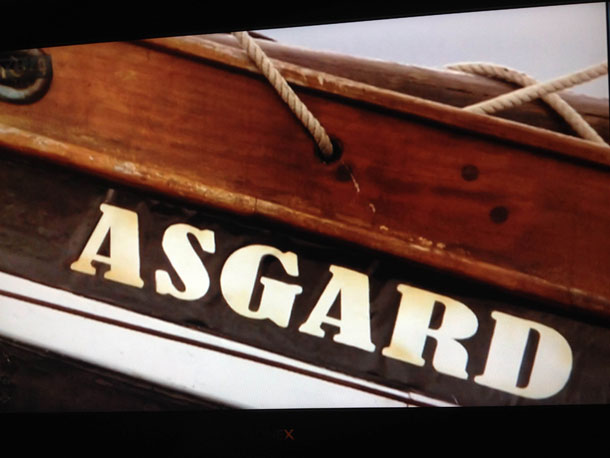
Actually, the plan was that Erskine Childers's yacht, the Asgard, navigated by Childers and his wife, should take over 900 rifles and 29,000 rounds of ammunition from the tug in the North Sea; while Conor O'Brien's yacht, Kelpie, should take the remainder which would be transferred to the yacht Chotah, owned by Sir Thomas Myles, off the Welsh coast. The Asgard was to proceed to Howth and the latter to Kilcoole. The yachts, it was hoped, would not be suspected of such an expedition.
For some weeks prior to 26 July, the Dublin Volunteers engaged each Sunday on long route marches to accustom themselves to the fatigue and, more important still, to throw off any suspicion which the British would have at seeing a large body of men heading for Howth. The Volunteers decided that they would take delivery of the arms in the same way as the Ulster Volunteers had done at Larne – in the broad daylight.
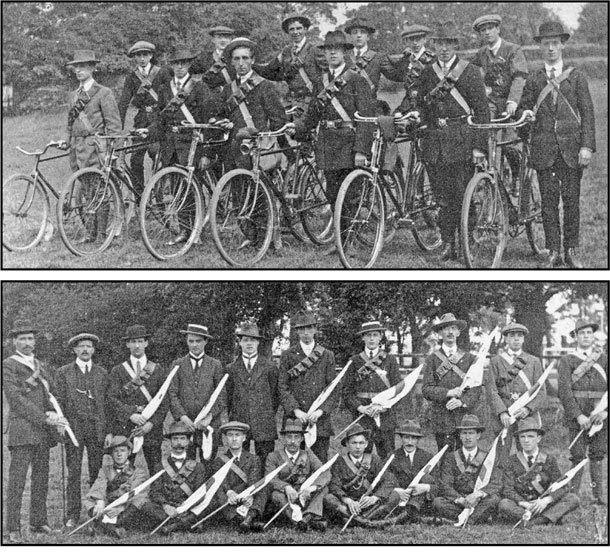
Accordingly, at 10am on the appointed date, some 700 Volunteers and members of Fianna Éireann paraded at Father Mathew Park, Fairview, and all but a few officers thought that they were starting on one of their regular route marches, this time to Portmarnock. Bulmer Hobson and Thomas MacDonagh were in charge and Cathal Brugha waited at Howth in command of a group of picked men.
The day was stormy and heavy. Showers fell as the men marched in good order. Leaving Fairview at 10:40, there were but two hours to cover the approximate eight miles. At Raheny, a short halt was made while one hundred Volunteers from Lusk and Swords joined the ranks. Here Hobson informed the officers of the real purpose and probably told them, also, that the Fianna trek-cart carried 150 heavy oak batons, which would come in useful should police or coastguards attempt to interfere.
As the Volunteers drew near Howth, the Asgard was already lying off Lambay Island. Altogether the yacht had been 19 days at sea, going and coming. The return journey was a hazardous one, through heavy seas. The guns had been unpacked en route and were piled in the cabin four feet high, which made the voyage doubly uncomfortable for the crew, who had to crouch in the apartment. The Asgard had passed through a naval review at Spithead and might have encountered HMS Forward in Dublin Bay but for the fact that the warship had been ordered to the Wicklow coast, the Volunteers having spread a rumour that gun-running was to take place there.
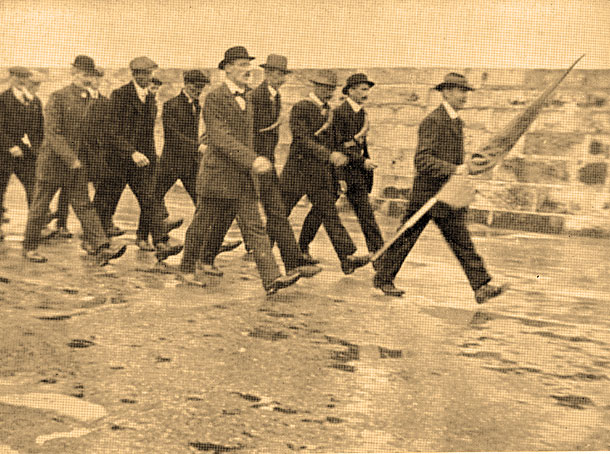
The men halted at the East Pier, in full view of the police, who stood at their barracks door curious but unsuspecting. Guards were detailed to deal with the police and coastguards and to keep the public off the pier.
Meanwhile, Childers was waiting for the "all ready" signal, which was to have been given by Darrell Figgis from a small boat. No boat appeared. Nevertheless, the Asgard's owner decided to put into port, a bold decision upon which depended the success of the enterprise, for HMS Forward returned to Howth some time later, its commander being apprised of events there.
The Asgard came alongside to the minute of its appointment. And as it did, the main body of Volunteers came down the pier at the double. Not a moment was wasted. Cathal Brugha's men were already taking delivery when the main body halted. Words could not describe the enthusiasm that followed, the rank and file having been, until then, without knowledge of their detail. The men formed chains and the rifles were passed from hand to hand down the pier. Six motor cars took the greater part of the ammunition to appointed places, and the Fianna loaded 2,000 rounds into their trek-cart. No ammunition was distributed.
The police vainly tried to pass the guard, and coastguards, who endeavoured to land from a boat, did not persist when challenged by men holding rifles, which they did not know were empty. A bare 20 minutes passed and the Irish Volunteers were swinging proudly down the pier, rifles at the slope.
In good order, the men reached Raheny, where Dublin Metropolitan Police and armed members of the Constabulary, who had been sent to intercept the march, wisely refrained from interfering with 800 riflemen. Outside Raheny, word was brought that police and military were assembled at Clontarf and, despite this, the Volunteer officers decided not to alter their route for the city. However, nearing Clontarf, the Volunteers swung off the main road to avoid the imposing array of soldiers that blocked the way. But Assistant Commissioner Harrel, who was in charge of the party, was evidently seeking trouble for, observing the move, he brought his men at the double by a detour. The police lined the pathway and the soldiers held the road, their bayonets fixed.
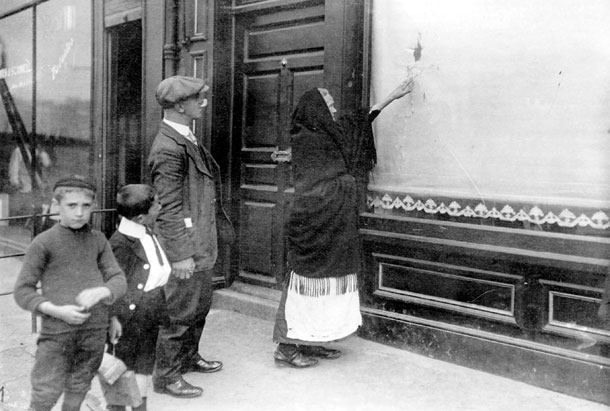
• A woman points out a bullet hole following the Bachelor’s Walk killings by British troops
Harrel held up his hand. Hobson, who was marching with Darrell Figgis at the head of the Volunteers, gave his men the order to halt. Hobson coolly asked Harrel his business. To which the Assistant Commissioner replied: "You are an illegal assembly. You have contravened the Arms Proclamation. Hand over the rifles peacefully or . . ." Hobson said simply: "You can't have them."
Harrel ordered his men to disarm the Volunteers and a number of policemen charged the ranks. Others, however, refused to obey his orders. A hand-to-hand fight followed, in the course of which some Volunteers fired pistol shots. The soldiers did not charge but a few Volunteers received bayonet wounds from contact with the military. The latter, though provoked by the pistol shots, which wounded two of their number, did not return the fire. It was a delicate situation for the Volunteers' leaders. No ammunition had been distributed and those who had loaded short-arms were under orders not to fire. The leaders, therefore, signaled their intention of parleying with the Assistant Commissioner of Police.
And while Thomas MacDonagh and Darrell Figgis argued with Mr Harrel, Bulmer Hobson passed the word along for the Volunteers to disperse from the rear and, going by way of the fields, for each man to make his way home with his rifle. And before Assistant Commissioner Harrel realised what had happened, and much to his disgust, the parade had dissolved .
Mr Harrel marched his men towards the city and was unsuccessful in his further efforts to intercept the Volunteers. The military – the King's Own Scottish Borderers – were followed through the city by a hostile crowd, who, it was said, threw stones at them. On reaching Bachelor's Walk, Major Haig, who was in charge, ordered the soldiers to prepare to fire upon the ringleaders. The soldiers, thoroughly out of hand, needed no further order but immediately opened fire at point-blank range, with the result that four people were killed and 38 wounded. The Royal Commission set up to investigate the occurrence reported against the military, being of the opinion "that no occasion had actually arisen for using loaded firearms”.
In the fracas at Clontarf, the Volunteers lost but 19 rifles, the majority of which were broken in the fray.
A week later, the second consignment was successfully landed at Kilcoole, County Wicklow.
Rough weather had forced the yacht Chotah into a Welsh harbour where it berthed for some days, having suffered a split mainsail. Thomas Myles and James Creed Meredith were the navigators. Seán Fitzgibbon and Seán T. O'Kelly were in charge of the Volunteer party, who took delivery of 600 rifles and 20,000 rounds of ammunition. The yacht anchored some distance from the shore and the men went out in motorboats to meet it. Near Kilcoole railway station, a number of motor vehicles were loaded and the cars proceeded to Dublin without serious incident.
Follow us on Facebook
An Phoblacht on Twitter
Uncomfortable Conversations

An initiative for dialogue
for reconciliation
— — — — — — —
Contributions from key figures in the churches, academia and wider civic society as well as senior republican figures




